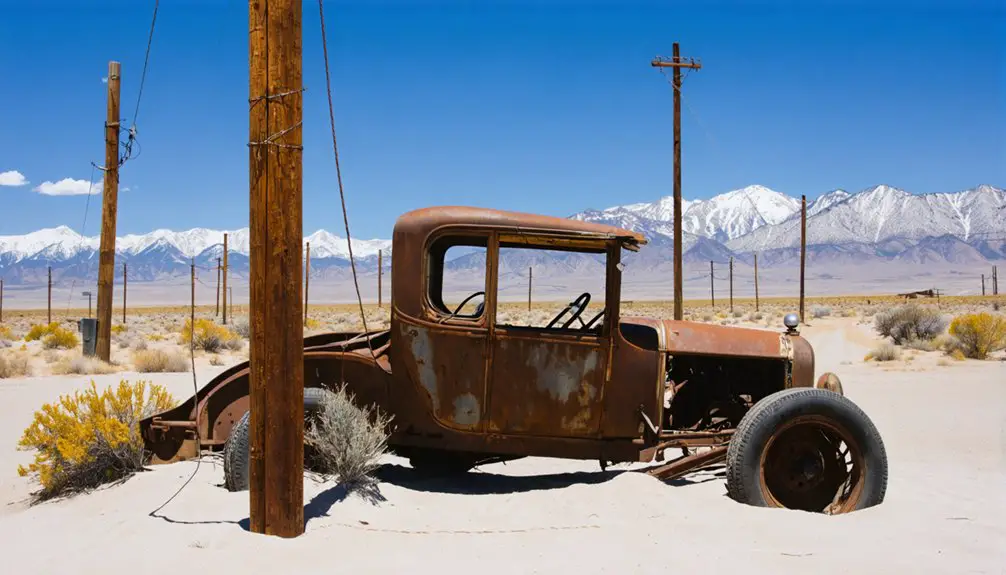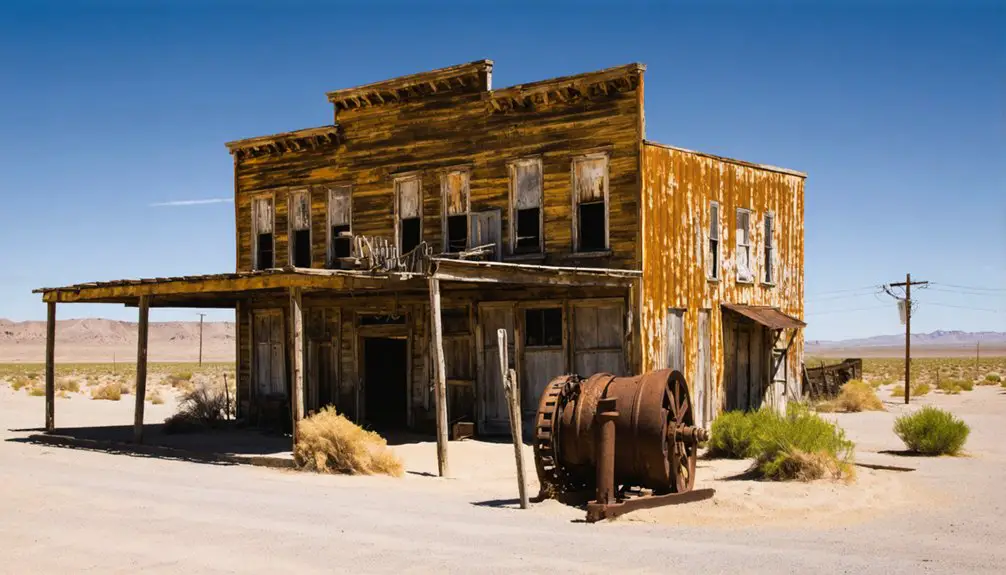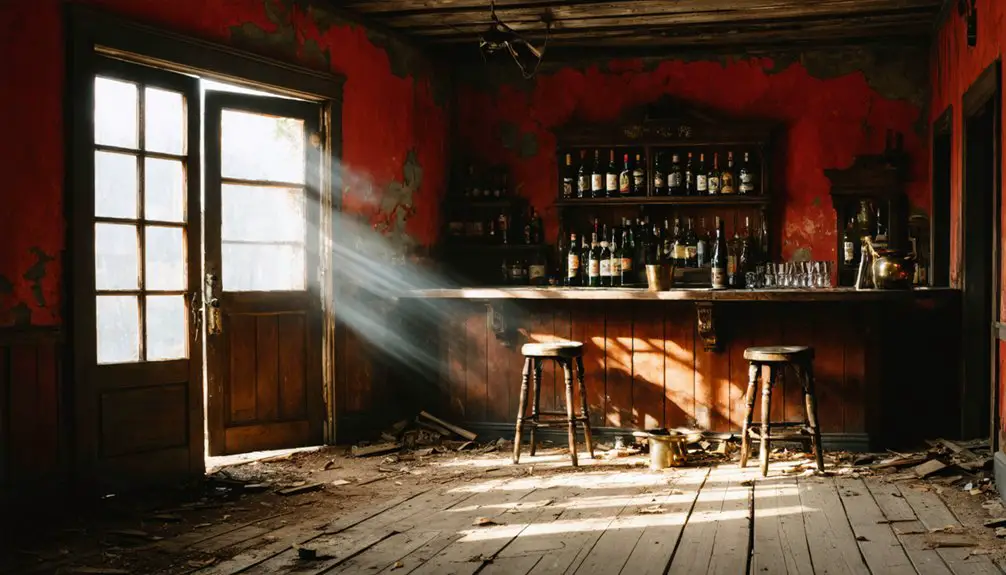You’ll find Pioneer, Nevada’s haunting remains tucked away in the Bullfrog Hills, where this once-thriving gold mining town reached its peak in 1908 with 2,500 residents. The town boasted hotels, saloons, and a ten-stamp mill during its heyday, but a devastating fire in 1909 marked the beginning of its decline. Today, scattered ruins, mining equipment fragments, and stone foundations dot the landscape, telling tales of Pioneer’s brief but dramatic chapter in Nevada’s mining history.
Key Takeaways
- Pioneer was a Nevada mining town that reached 2,500 residents in 1909 before declining due to fire damage and economic challenges.
- The town’s prosperity centered around gold mining operations, featuring a ten-stamp mill that processed ore from 1907 to 1916.
- A devastating fire in May 1909 destroyed much of Pioneer’s business district, marking the beginning of the town’s decline.
- The community included hotels, stores, saloons, and a school with 44 children during its peak period.
- Today, Pioneer exists as a ghost town with scattered ruins, mining equipment remnants, and two stamp mill sites.
Gold Rush Origins and Early Days
While the California Gold Rush drew thousands westward in 1848, Nevada’s mineral wealth remained largely untapped until Abner Blackburn’s gold discovery near Gold Canyon in July 1849.
You’ll find that William Prouse’s subsequent discovery in 1850 attracted more prospectors, though many initially bypassed the area for California’s seemingly richer deposits. Like the mining towns of California, these early settlements struggled with lawlessness and a lack of formal governance.
The area’s true value emerged when prospectors searching for gold unexpectedly found the Comstock Lode, which became America’s richest silver deposit.
Life in Upper and Lower Pioneer
Pioneer’s development into distinct sectors reflected the organic growth patterns common to Nevada mining settlements. You’d find Upper Pioneer clustered around the original mining operations, while Lower Pioneer emerged through formal town planning in 1908. Like many towns including Genoa, Pioneer adapted and grew from its early trading roots.
Upper and Lower Pioneer evolved naturally, mirroring Nevada’s typical mining town growth – one organic, one planned.
The community dynamics centered around key gathering spots like the Holland House hotel, which they’d relocated from Beatty to serve as the town’s premier social hub. The devastating fire of 1909 forced residents to rebuild much of the business district, marking a turning point in the town’s development.
You could’ve witnessed a bustling population of 2,500 residents by 1909, living among 300 buildings. Social gatherings thrived thanks to daily stagecoach services and early automobiles connecting the two sections.
Miners, merchants, and service providers formed a tight-knit community, adapting to harsh desert conditions. They’d often salvage and relocate buildings from declining nearby towns, showing the resourcefulness that defined frontier life.
The Great Fire of 1909
A devastating fire swept through Pioneer in May 1909, destroying much of the town’s bustling business district. The combination of wooden buildings, dry desert conditions, and strong winds created the perfect storm for disaster. Similar to the devastating Great Fire of 1910, dry conditions and strong winds fueled uncontrollable flames.
Much like the volunteer firefighters of Virginia City, local residents banded together to battle the flames. You’ll find that the fire aftermath left hotels, stores, and saloons in ruins, crippling the town’s economic heart.
Despite showing community resilience through rebuilding efforts, including reopening the school with 44 students, Pioneer struggled to recover. The fire coincided with a local banking crisis, and by fall 1909, school enrollment had dropped to 24 as families moved away.
You can trace the town’s decline through events like the “Hard Times Dance” and the forced sale of the Holland Hotel for taxes. The fire marked a turning point from which Pioneer never fully recovered.
Mining Operations and Production
You’ll find evidence of significant gold production in Pioneer’s two main operations: the Mayflower and Pioneer gold mines, both situated on Bullfrog Hills’ north side.
Like the nearby district of Bullfrog that experienced transformation from a tent city to boomtown, Pioneer saw rapid development of its mining infrastructure.
The Pioneer Mine‘s ten-stamp mill processed ore continuously from 1907 through 1916, representing the most active period of the town’s mining operations.
While exact production figures for Pioneer aren’t available, the mines contributed to the broader Bullfrog Mining District‘s notable gold output during Nevada’s early 20th-century mining boom.
Similar to the Pioneer Hotel & Gambling that would later operate in nearby Laughlin, the town’s mining operations attracted many hopeful prospectors to the area.
Gold Production Statistics
Nevada’s gold production ranks among the most significant in the United States, consistently generating 77-78% of the nation’s total gold output and roughly 5% of global production.
The Carlin Trend stands as one of Earth’s richest gold-producing districts, having yielded nearly 100 million ounces throughout its history.
You’ll find gold production trends have shifted remarkably in recent years, with output decreasing from 5.58 million troy ounces in 2018 to 4.04 million troy ounces in 2022. Despite this decline, mining revenue remains substantial, with Nevada Gold Mines alone generating $3.8 billion in 2020.
The state’s cumulative gold production from 1835 to 2017 reached an impressive 205.9 million troy ounces, valued at $322.6 billion in 2020 terms.
This remarkable output comes from just 32 mining operations, which occupy less than 0.25% of Nevada’s total land area while employing over 15,000 workers at an average salary of $103,000 annually. The historic Goldfield district contributed significantly to Nevada’s gold legacy, producing 4.2 million troy ounces through 1959.
Mining Equipment Operations
The mining operations in Pioneer revolved around sophisticated equipment and infrastructure that defined early 20th-century gold extraction.
You’ll find that mining machinery innovations centered on the ten-stamp mill, which crushed ore before processing through the MacArthur-Forrest cyanide method. This system replaced older mercury amalgamation techniques, marking a significant advance in extraction efficiency.
Ore processing techniques evolved with the introduction of electrical power and vacuum filtration systems, while specialized derricks and booms helped move materials throughout the operation.
The mining network included both underground tunnels reaching depths of 150 feet and open-pit extractions.
You’ll notice that tributers worked various claims, sending their ore to centralized mills where complex chemistry and modern equipment maximized gold recovery from the raw material.
Transportation and Communication Networks

As Pioneer developed into a bustling mining town, multiple transportation networks emerged to connect it with neighboring settlements and distant markets.
Pioneer’s evolution sparked a web of vital transport routes, linking this thriving mining hub to surrounding communities and faraway trading centers.
You’d find the Tonopah and Tidewater Railroad linking Pioneer to Rhyolite, while daily stagecoaches ran between Pioneer and Springdale. Teams of horses and mules pulled freight wagons across the Bullfrog Mining District, connecting to the nearest railroad terminus.
Communication challenges were addressed through various methods. You could read local news in the Beatty Bullfrog Miner and Rhyolite Herald, while mail service operated through stations like Desert Well.
The railroad system doubled as a crucial communication link, carrying mail and parcels throughout the region. These transportation methods and communication networks thrived during Pioneer’s peak but gradually declined alongside the town’s mining operations.
Daily Life in a Booming Mining Town
Life in booming Pioneer centered around a vibrant mix of businesses and services you’d expect in an early 1900s mining town. You’d find everything from the local drug store and meat market to multiple saloons and a doctor’s office.
For lodging, you could choose between boarding houses, the Holland Hotel, or build your own residence ranging from a simple tent to a wooden structure.
Community institutions shaped daily routines, with 44 children attending the local school at its peak. You’d gather for social events like the “Hard Times Dance” at the Holland Hotel to boost spirits during challenging periods.
While water had to be hauled in from distant springs, the town offered modern amenities like electricity and telephone service, making life more comfortable despite the harsh mining environment.
The Path to Abandonment

Despite Pioneer’s bustling community life, troubling events in 1909 marked the beginning of its decline. A devastating fire destroyed much of the business district in May, while litigation effects from disputes over mine ownership stalled operations. Financial instability deepened when the First National Bank of Rhyolite failed, cutting off crucial investment capital.
You can trace Pioneer’s downward spiral through its rapid population drop – from 2,500 in 1908 to just 700 by 1910. The town’s isolation and lack of railroad connections made recovery difficult.
As easily accessible ore depleted and mining techniques became outdated, companies cut back production or closed. Water scarcity and harsh desert conditions drove more residents away.
What Remains Today
The physical remnants of Pioneer tell a sparse but revealing story today. You’ll find scattered ruins and mining debris rather than the iconic structures common in other Nevada ghost towns.
While fire claimed many of Pyramid City’s original buildings, the more remote Upper Pyramid area retains visible stone and wooden remnants scattered up the canyon.
Two stamp mill sites and mining equipment fragments mark Pioneer’s industrial past, though they’re now weathered by over a century of exposure.
Your exploration will reveal foundations, machinery pieces, and ore processing remnants across the rugged landscape. The dry northern Nevada climate has created conditions of “arrested decay,” preserving what’s left in a natural, deteriorated state.
While the current remains are minimal, they offer an authentic, unrestricted ghost town experience.
Frequently Asked Questions
Were There Any Notorious Crimes or Criminals in Pioneer During Its Heyday?
Like a blank canvas, Pioneer’s history shows no notorious crimes or criminals during its peak years. You won’t find records of major lawlessness in this mining town’s short-lived heyday.
What Happened to the Residents After Pioneer Became a Ghost Town?
You’ll find the residents scattered widely, following pioneer migration patterns to nearby towns like Beatty and Tonopah, or across Nevada seeking new jobs after mining ceased, leaving ghost town preservation efforts behind.
Did Any Famous People Ever Visit or Live in Pioneer?
You won’t find records of famous visitors or historic figures in Pioneer’s story. There’s no credible evidence that any well-known personalities ever lived in or visited this mining town.
Were There Any Schools or Churches Established in Pioneer?
You won’t find clear evidence of Pioneer Education or Pioneer Religion in historical records. While mining towns often had schools and churches, Pioneer’s brief boom and 1909 fire likely prevented their establishment.
What Native American Tribes Originally Inhabited the Area Around Pioneer?
Like ancient guardians of the desert, you’ll find the Numa (Northern Paiute), Washeshu (Washoe), Newe (Shoshone), and Nuwuvi (Southern Paiute) tribes originally inhabited this land, leaving their sacred imprint across time.
References
- https://www.destination4x4.com/pioneer-nevada-ghost-town-nye-county/
- https://www.ghosttowns.com/states/nv/pioneer.htm
- https://en.wikipedia.org/wiki/Pioneer
- https://www.smithsonianmag.com/sponsored/nevadas-living-and-abandoned-ghost-towns-180983342/
- https://special.library.unlv.edu/boomtown/counties/nye.php
- https://shpo.nv.gov/nevadas-historical-markers/historical-markers/nevadas-first-gold-discovery
- https://www.mgsrefining.com/blog/what-was-the-nevada-silver-rush-and-why-was-it-special/
- https://blog.midwestind.com/brief-history-gold-rush/
- https://en.wikipedia.org/wiki/California_gold_rush
- https://www.youtube.com/watch?v=rEUdQpNxZIk



